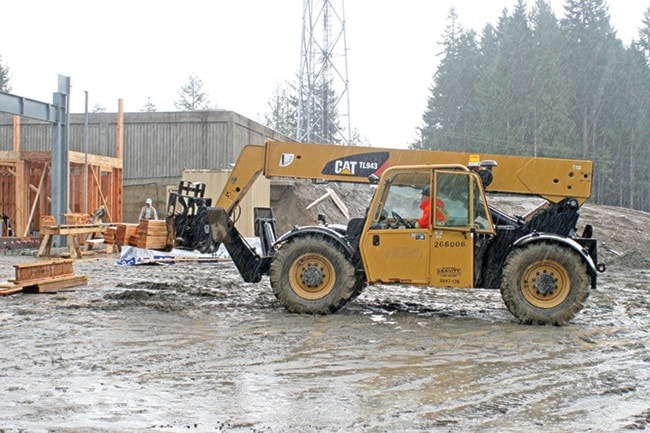Qualicum Beach is building the country's most environmentally-friendly fire hall.
"Our goal was to be 75 per cent more efficient than the next most efficient fire hall in Canada; right now we're at about 73 per cent," said project manager Walter Hoogland.
In that calculation, he included the installation of solar panels on the roof, for which they are waiting for a $400-$500,000 grant from the Federation of Canadian Municipalities' Green Municipal Fund.
The energy efficiency measures include everything from LED lighting, low flow toilets, reused materials, in-floor heating, lots of windows to decrease light use and as much local material as possible.
"The goal was to source everything within 500 kilometres," Hoogland said, listing off materials from much closer, including the concrete and finishing cedar from Coombs, the cladding from Nanaimo and the extensive glass from Victoria.
The building will not be officially LEED (Leadership in Energy and Environmental Design) certified, but will still meet or surpass the LEED requirements.
Mayor Teunis Westbroek said the efficiency aspect will cost more up front but save operating costs in the long term.
The need for a new fire hall has been talked about for years in Qualicum Beach and got rolling in 2007 when the current site — 150 Rupert Road, by the roundabout — was chosen.
Council developed a financial plan in 2009 which includes a one per cent property tax increase (average $14 per property) every year for five years, starting last year.
That will bring in about $500,000 and Westbroek said they never stop looking for ways to save money and applying for grants to help cut down the amount they will eventually have to borrow.
The total cost is estimated at $6.5 million, which John Marsh, acting as chief administrative officer at the time, previously said includes absolutely everything, right down to the furniture.
Along with expansion space, the new hall will include facilities for the volunteer fire fighters, including a fitness gym, day-use room with kitchen, lots of storage and properly designed rooms for gear and breathing apparatus, including hazmat decontamination.
Built to post-disaster standards, the building would also be crucial in any major emergency like an earthquake, acting as an emergency services hub and potentially providing shelter.
Westbroek said the town's fire hall working group, led by Hoogland, was instrumental in planning the project and deciding what it should include, working by consensus.
"The working group really did their homework," said Hoogland, wanting to thank the three civilian, or resident members specifically: Jason Davies, Greg Husband and Sandy Vogstad.
The group also included senior town staff like Director of Planning Luke Sales, Director of Engineering Bob Weir, and eventually the chosen architect and engineer. Each member of council also attended at least one of the monthly meetings, Hoogland said.
The group developed four basic design options and chose the one with the best traffic flow, where fire trucks enter the property on the east side, drive around to the back of the building and enter four, extra-long drive-through bays, exiting straight out onto Rupert Road.
Hoogland said the group found the location to be ideal, providing the best access to town, the highway and surrounding communities for the increasingly important mutual aid work they do.
"There hasn't been a lot of opposition," Westbroek said. "Questions come up about certain costs, or the size of the budget, but I think those are usually answered."
"We did everything through consensus and got everything we needed for these guys for the next 50 years," Hoogland said on a recent site tour in the mud and driving rain.
They were scheduled to have a 100-ton crane lifting large sections of laminate pre-fabricated floor panels, but the wind was too strong and part of their shipment was delayed by ferry cancellations due to the wind.
Weather is often an issue on big projects, said Dennis Brooks, construction manager with general contractor Windley Contracting.
They are about a month behind schedule, due to the weather and some design changes, but everything is progressing nicely, Westbroek said.
Construction started this summer and with the use of pre-fabricated components, Brooks said things will come together very quickly when the weather cooperates.
The goal is to get the bulk of the structure up before Christmas, which will give them a sheltered, controlled environment to work in for the next six months, hoping to finish by the summer.
